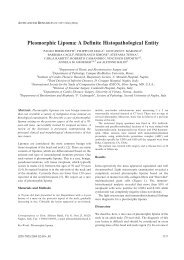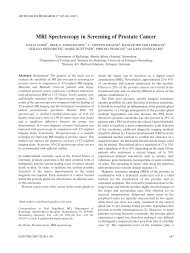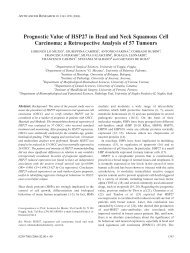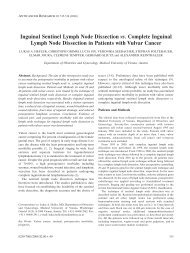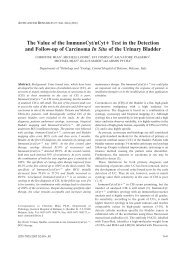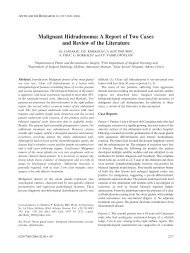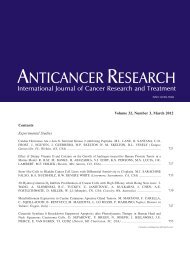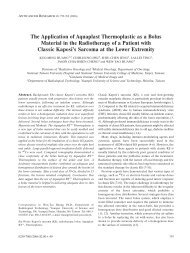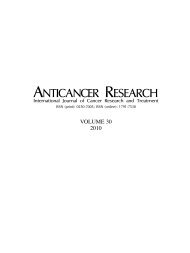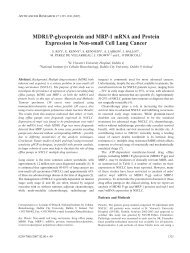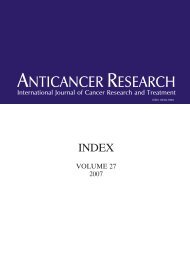ABSTRACTS OF THE 21st ANNUAL MEETING OF THE ITALIAN ...
ABSTRACTS OF THE 21st ANNUAL MEETING OF THE ITALIAN ...
ABSTRACTS OF THE 21st ANNUAL MEETING OF THE ITALIAN ...
Create successful ePaper yourself
Turn your PDF publications into a flip-book with our unique Google optimized e-Paper software.
in either group showed >G2 acute intestinal or urological<br />
toxicity. Among Group 1 patients, 32 (44.4%) had no urinary<br />
toxicity and 40 (55.6%) had G1-G2 urinary toxicity; 51<br />
patients (51.8%) had no rectal toxicity and 21 (29.2%) had<br />
G1-G2 rectal toxicity. Among Group 2 patients, 9 (31%) had<br />
G0 urinary toxicity and 20 (69%) had G1-G2 urinary toxicity;<br />
25 patients (86.2%) had G0 rectal toxicity and 4 patients<br />
(13.8%) had G1-G2 rectal toxicity. There was no significant<br />
correlation between acute urinary or rectal toxicity and the age<br />
of patients (p=0.43 and p=0.269, respectively) under bivariate<br />
analysis. There was no significant correlation for acute<br />
intestinal and urological toxicity under multivariate analysis.<br />
Discussion and Conclusion: Radical radiotherapy for localized<br />
prostate carcinoma is an effective treatment option in elderly<br />
patients. This analysis demonstrates that age has no significant<br />
impact on radiation-induced intestinal and urological acute<br />
toxicity and can be safely used as curative treatment for<br />
prostate cancer patients older than 75 years.<br />
171<br />
HYP<strong>OF</strong>RACTIONATED IG-IMRT AND ACUTE<br />
TOXICITY IN PROSTATE CANCER: <strong>THE</strong><br />
EXPERIENCE <strong>OF</strong> <strong>THE</strong> DEPARTMENT <strong>OF</strong><br />
RADIO<strong>THE</strong>RAPY SANT’ORSOLA-MALPIGHI<br />
HOSPITAL, BOLOGNA<br />
Mirko Mazza1 , Antonio Malorgio1 , Feisal Bunkheila1 ,<br />
Silvia Cammelli1 , Maria Ntreta1 , Annalisa Angelini1 ,<br />
Alessandro Bertaccini2 , Renzo Mazzarotto1 and Enza Barbieri1 1Istituto di Radioterapia and 2Clinica Urologica Policlinico<br />
S. Orsola-Malpighi, Bologna, Italy<br />
Background: In recent years, image-guided radiation therapy<br />
(IGRT) has taken a leading role in prostate cancer treatment,<br />
allowing optimization of the target irradiation technique<br />
through the use of the intensity-modulated radiation therapy<br />
(IMRT) supplied in a hypofractionated regime. The endpoint is<br />
to improve patient outcome, both in terms of local control of<br />
the disease and in terms of reduction of radiotherapy toxicity.<br />
Aim: The aim of this study was to provide preliminary data of<br />
our experience related to gastrointestinal (GI) and<br />
genitourinary (GU) toxicity profiles of those patients who have<br />
completed this treatment. Patients and Methods: Between<br />
October 2010 and February 2011, 18 patients affected by<br />
intermediate- to high-risk prostate cancer have been treated at<br />
the Radiotherapy Department of Policlinico S. Orsola-<br />
Malpighi of Bologna. The placement of three gold fiducial<br />
markers inside the prostatic gland was planned first by the use<br />
of ultrasound guidance, and then, after two to three weeks,<br />
computed tomography and magnetic resonance imaging. The<br />
total dose delivered to clinical target was 67.5 Gy (25 fractions<br />
1902<br />
ANTICANCER RESEARCH 31: 1807-1956 (2011)<br />
of 2.7 Gy each). Results: Acute toxicity was evaluated during<br />
treatment through the use of the EORTC-RTOG toxicity<br />
grading scale with the following results. GI toxicity: 15<br />
patients G0, 3 patients G1. GU toxicity: 13 patients G0, 5<br />
patients G1. Conclusion: Although this study did not include<br />
a sufficiently meaningful number of patients, it is possible to<br />
conclude that the hypofractionated regime with IG-IMRT is a<br />
very well tolerated treatment.<br />
172<br />
HIGH-DOSE CURATIVE RADIO<strong>THE</strong>RAPY<br />
FOR PROSTATE CANCER: RECTAL<br />
DOSE-VOLUME CONSTRAINTS AND<br />
ACUTE INTESTINAL TOXICITY<br />
Angelo Errico1 , Michele Battaglia2 , Annalisa Natuno1 ,<br />
Maria Paola Ciliberti1 , Dora Di Cosmo1 , Giuseppe Squeo1 ,<br />
Stefania Carbone1 , Pierangela Nardella3 , Nicola Caretto4 ,<br />
Francesco Lafranceschina2 , Francesco Paolo Selvaggi2 and Santa Bambace1 1U.O.C Radioterapia Oncologica and 4U.O.C. Fisica<br />
Sanitaria, Ospedale “R. Dimiccoli”, Barletta, Italy;<br />
2Urologia Universitaria I-Policlinico di Bari, Italy;<br />
3Istituto di Igiene, Università Cattolica del Sacro Cuore,<br />
Roma, Italy<br />
Aim: To assess the impact of rectal dose-volume constraint on<br />
acute gastrointestinal (GI) toxicity in patients with nonmetastatic<br />
localized and locally advanced prostate cancer<br />
treated with high-dose curative radiotherapy. Patients and<br />
Methods: Between June 2008 and May 2010, 101 patients<br />
with prostate cancer received conventionally fractionated<br />
three-dimensional conformal radiotherapy in our institution.<br />
For intermediate- and high-risk patients, total dose to the<br />
prostate ranged from 78 Gy to 80 Gy (2 Gy/fraction) and total<br />
dose to the seminal vesicles ranged from 64 Gy to 70 Gy. No<br />
patient received pelvic lymph node irradiation. Low-risk<br />
patients (eight patients) received 80 Gy to the prostate and the<br />
base of seminal vesicles. The median age of the patients was<br />
73 (range 51-81) years. The median PSA was 9.3 (range 0.89-<br />
89.3) ng/ml and 31% of patients had Gleason score (GS) ≤6,<br />
32% of patients had GS=7 and 37% of patients had GS≥8.<br />
Almost all patients (91%) received hormonotherapy before<br />
and during radiotherapy. GI toxicity was assessed weekly<br />
according to the RTOG toxicity scale. The complete rectal<br />
wall, from the rectosigmoid flexure to the anal verge, was<br />
contoured as an organ at risk. An empty rectum (rectal volume<br />
55% nor V70>25%. We retrospectively re-assessed our<br />
data according to the recent constraints proposed by the



